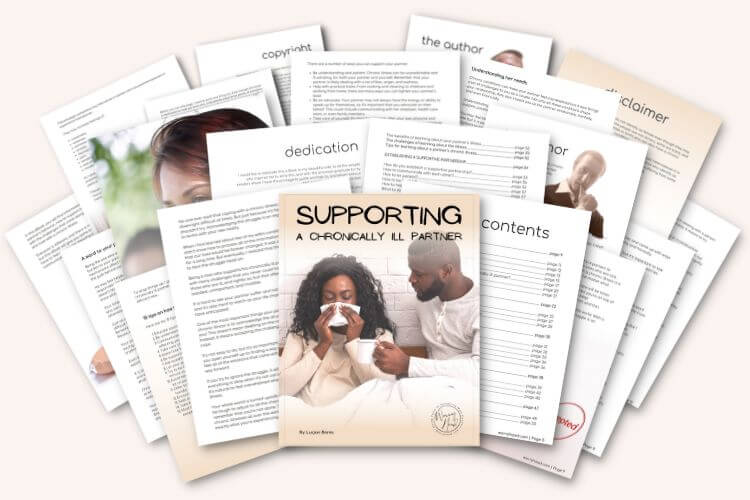Husband’s guide to supporting a chronically ill wife financially.
There are many ways you can support your chronically ill wife financially, but before I get to that point, I want to stress the importance of your understanding of how living with chronic illness affects your wife.
This isn’t something you can understand unless you’ve experienced it yourself.
It’s not just about the physical pain or discomfort that comes with the disease. It’s also about psychological effects, such as feeling isolated and not being able to do the things you used to do.
This is why it’s important to understand life with chronic illness and be as supportive as possible, providing her with emotional support, especially with the financial toll it has on you both.
It’s important to support your wife financially with many treatments and medications that can be expensive, so you need to make sure you have enough money budgeted for the disease treatment costs.
In today’s times, people struggle to afford their health insurance.
But life with chronic illness doesn’t have to be miserable. There are ways to make life enjoyable and meaningful, even if it’s different than life before.
But to feel happy and secure, you will always need money to avoid financial hardship.
The myth of financial security.
There is no such thing as financial security, at least not with a traditional job. When you work your typical 9-5, you work for someone else. You work for their happiness, not yours.
You are NOT in control, your employer is.
Many traditional 9 to 5 jobs have a limit to how much you can earn. You have to beg for a promotion, and even then, the increase in your salary may not be significant enough to keep up with inflation or your increasing expenses.
In addition, if you were to lose your job, you have no other sources of earnings to fall back on.
Any financial advisor will tell you that there is no such thing as permanent life insurance when it comes to chronic disease because the chronic disease usually progresses, and you would need to add more to the pot in order to feel “secure.
You will always need more money.
What can you do?
Build your own business, ideally digital. Artificial intelligence is on the rise, and after Covid-19 people began to discover the possibility of remote work and working from home.
Don’t invest in stocks or other commodities because you will still be at the mercy of others. If they fail, you will too.
With a digital business, however, you can make sure that your wife’s life can become secure, enjoyable, and meaningful again. You will have full control over your lives, your time, and your money.
How can you support your chronically ill wife financially?
From my own personal experience, I decided to give you 7 tips where six are dedicated to financial aspects, but the first one is about the two most important things – communication and partnership.
- Communication with the new normal.
- Understand the financial impact.
- Budget creation.
- Financial assistance.
- Disability insurance.
- Changes in income.
- Professional financial advice.
Before I discuss ways of supporting a chronically ill wife financially, I want to share with you one of my eBooks. If you want more in-depth information about how to support your partner with her chronic conditions and how to cope with the new normal in your relationship? If so, I wrote a “Supporting a Chronically Ill Partner” e-Book.
You can get the 1st Chapter of the e-Book for FREE, and if you like it, you’ll get a Whopping 33% Discount on the Whole Book, plus discounts on other helpful tools. You have nothing to lose but a lot to gain!
The first chapter alone contains a lot of information for both of you about acknowledging the struggles, including:
- A word to your partner.
- A word to you.
- Stepping on eggshells.
- Understanding her needs.
- How to acknowledge having a chronically ill partner?
- Acknowledging can be hard.
- 15 tips on how to do it!
Get the 1st Chapter FREE!
Chronic Illness for Partners

Communication and partnership with the new normal.
Spend quality time with her because life with chronic illness can be hard, so make sure you are there for your wife and make life feel a bit normal.
Being a supportive partner matters the most because you are a team, you are both in this together, and in order to create a loving and supportive partnership, communication is key. Communicate with your wife about the impacts of her disease, and be as helpful as possible.
Remember, life with chronic illness doesn’t have to mean life without fun. You should still try to find ways to enjoy life together, even if it has to be done from home.
It’s important for you to have open and honest communication with your wife about the impact of her condition and to work together in order to find solutions. This can help to alleviate stress and ensure that both of you are on the same page when it comes to managing your wife’s condition financially.
Understand the financial impact of chronic illness.
If someone is terminally ill, doctors and society take that person more seriously as opposed to one with a chronic condition that isn’t terminal. This isn’t fair.
This is why it is important to have a good understanding of your wife’s condition. For me, it was endometriosis and fibromyalgia. To begin with, I could barely spell the words, let alone understand these medical issues.
When one spouse is chronically ill and the other person is healthy, it can seem unfair on both sides. But I had to learn in order to become the best supportive partner I could be.
Thinking of financial hardships should include any medical expenses, treatments, and other financial affairs associated with a chronic disease.
This will help you to understand the financial aspects of her condition in your household and make informed decisions about how to control it. It must include an understanding of the potential loss of earnings if your wife is unable to work due to her condition.
Create a budget.
Based on your understanding of the impact of your wife’s condition, create a budget that accounts for all necessary spending.
When your wife is always sick, as her husband, you need to take control. That includes a number of various medical spending you need to consider:
- Doctor’s visits: Regular visits to doctors and specialists are often necessary to cope with your wife’s condition. These visits can be costly, especially if they are not covered. In my wife’s case, endometriosis requires repetitive surgeries. This can get costly.
- Medications: My wife doesn’t take any meds, but yours may require ongoing medication to manage her condition. These medications can be expensive, and the cost can add up over time.
- Treatments: Depending on your wife’s chronic condition, she might require some additional treatments, such as physical therapy or occupational therapy. These treatments can also be costly. My wife likes a holistic approach, but exercises such as pilates can also be costly.
- Tests and diagnostic procedures: Even though my wife requires regular tests and diagnostic procedures to monitor her condition and make sure that it is being properly managed, we live in the United Kingdom, so as long we pay taxes, her treatment is covered. That may not be the case for you and your wife.
- Equipment: Your wife may require special equipment, such as a wheelchair or a hospital bed, to manage her condition. These items can be expensive, and the cost of maintaining and replacing them over time can add up. But again, it varies from person to person.
- Home care: My wife works from home and doesn’t have any care such as nursing care, domestic care, etc. However, being a medical secretary, she needed to buy tools such as a comfortable chair, laptop, headphones, and more, in order to fully work from home. Your wife may need other services that can be costly and may require additional financial input on your part, for example, transportation to and from appointments.
- Travel expenses: As I mentioned above, if my wife’s condition requires her to travel to various doctors or hospitals for treatment or specialist appointments, we will have to consider the cost of transportation and lodging.
All of this should help you understand exactly how much money you need to manage your wife’s condition and make sure that you have enough to cover all necessary spending. My wife would make a great accountant, she manages money in an amazing fashion. She also saves a lot!
It is important to keep in mind that these costs may vary depending on the specific condition, severity, and type of treatment.

Financial assistance.
Since the majority of my readers come from three English-speaking countries, I wanted to share with you what kind of financial assistance is available for chronically ill people in the United Kingdom, the United States, and Canada.
In the United Kingdom, there are a number of financial assistance programs available for chronically ill people, including:
- Personal Independence Payment (PIP): This is a tax-free benefit for people with long-term health conditions or disabilities. It is intended to help with the extra costs of living with a chronic illness or disability.
- Disability Living Allowance (DLA): This is a benefit for people under the age of 65 who have long-term health conditions or disabilities. It is intended to help with the extra costs of living with a chronic illness or disability.
- Attendance Allowance (AA): This is a benefit for people aged 65 and over who have long-term health conditions or disabilities. It is intended to help with the extra costs of living with a chronic illness or disability.
- Blue Badge parking permit: This is a parking permit for people with disabilities, including those with chronic illnesses, that allows them to park in designated disabled parking spaces.
In the United States, there are a number of financial assistance programs available for chronically ill people, including:
- Medicaid: This is a joint federal and state program that provides health coverage to low-income individuals, including those with chronic illnesses.
- Medicare: This is a federal program that provides health coverage to individuals who are 65 or older, or who have certain disabilities, including chronic illnesses.
- Social Security Disability Insurance (SSDI): This is a federal program that provides financial assistance to individuals who are unable to work due to a chronic illness or disability.
- Supplemental Security Income (SSI): This is a federal program that provides financial assistance to low-earning individuals who are disabled or elderly, including those with chronic illnesses.
In Canada, there are a number of financial assistance programs available for chronically ill people, including:
- Canada Pension Plan Disability (CPP-D): This is a federal program that provides financial assistance to individuals who are unable to work due to a chronic illness or disability.
- Ontario Disability Support Program (ODSP): This is a provincial program that provides financial assistance to low-earning individuals with disabilities, including those with chronic illnesses.
- Canada’s Non-insured Health Benefits (NIHB) program: This program offers coverage for some health-related goods and eligibility for First Nations and Inuit individuals that are not covered by private or provincial/territorial health plans.
- Canada’s Medical expense tax credit: This is a credit that individuals can claim on their tax return eligible for their medical expenses, including certain health care costs related to chronic illnesses.
Bear in mind that depending on the institution and circumstances, your wife may not be eligible for all benefits. Just because my wife can walk, her PIP was declined, regardless of how horrifically disabled endometriosis and fibromyalgia make her feel…
Disability insurance.
And what about disability insurance in the United Kingdom, the United States, and Canada?
In our country – the United Kingdom, it is typically offered through private providers, rather than through government programs.
There are a few different types of disability insurance available in the UK, including:
- Income protection insurance: This type provides regular earnings if you are unable to work due to a chronic illness or disability.
- Critical illness insurance: This type provides a lump sum payment if you are diagnosed with a specified critical illness, such as cancer or heart disease.
- Personal accident insurance: This type provides a lump sum payment if you are unable to work due to an accident, such as a broken bone or head injury.
It is a little bit different in the United States, as it is typically offered through private providers, as well as through some employer-sponsored benefits programs.
There are a few different types of disability insurance available in the US, including:
- Short-term disability insurance: This type provides temporary wage replacement if you are unable to work due to a chronic illness or injury.
- Long-term disability insurance: This type provides long-term wage replacement if you are unable to work due to a chronic illness or injury.
- Private disability insurance: Some individuals may choose to purchase a private option in addition to any coverage they may have through their employer.
In Canada, disability insurance is typically offered through private providers, as well as through some employer-sponsored benefits programs.
There are a few different types of disability insurance available in Canada, including:
- Short-term disability insurance: This type of insurance provides temporary earnings replacement if you are unable to work due to a chronic illness or injury.
- Long-term disability insurance: This type provides long-term wage replacement if you are unable to work due to a chronic illness or injury.
- Private disability insurance: Some individuals may choose to purchase private disability insurance in addition to any coverage they may have through their employer.
The availability and options of these programs may vary depending on the country, the insurance provider, and the individual’s employment status, so it’s recommended to check with insurance providers and/or employer-sponsored benefits programs for the most up-to-date information.

Changes in income.
I need to stress, as I experienced this with my wife many times, what are some ways to decrease your spending, how to cut expenses to save money, and lastly, what side hustles to do in order to increase earnings?
Let’s begin with some ways to decrease spending, cut expenses and save money…
- One of the most effective ways to decrease spending is to create a budget and stick to it. Identify your specific income and fixed expenses, and then allocate a specific amount for discretionary spending.
- Review your expenses and look for areas where you can cut back. This may include canceling subscriptions or memberships you no longer use or need, switching to a cheaper phone plan, or cutting back on dining out. We had to cut on professional dancing and gym.
- Shop for deals and discounts. When shopping for groceries and other necessities, look for deals and discounts. This may include using coupons, shopping at discount stores, or buying in bulk. This always cuts costs.
- Lower your utilities, and other bills by using energy-efficient appliances. You can lower your thermostat, and unplug electronics when they’re not in use.
- Reduce transport. Reducing transportation costs by biking or taking public transportation is a great way to decrease your spending. If you have to drive, try to consolidate your errands to save on gas.
- Review and reduce insurance coverage: Review it and see if you can reduce or eliminate any unnecessary coverage.
- If you have to refinance your loans to get a lower interest rate and reduce the amount of interest you pay over time, do so.
- Sell items you no longer need or want on online marketplaces like eBay or social media such as Facebook Marketplace, or have even a garage sale.
- Avoid impulse buying. Don’t go shopping when you are hungry as you are likely to buy unnecessary snacks. Try to avoid impulse buying by making a list of what you need before you go shopping and sticking to it.
- Prioritize your expenses and focus on the most important ones you need. This may include your mortgage or rent, utilities, transportation, and groceries. No more.
Here are some examples of side hustles to increase your income:
- Starting a small business, such as selling products online or providing tutoring, pet-sitting, or lawn care (I’ll get to that by the end of this article)
- Renting out a spare room on Airbnb or renting out a car on Turo
- Participating in online surveys or focus groups
- Providing freelance support such as writing, graphic design, or programming
- Selling items you no longer need or want on online marketplaces like eBay or Facebook Marketplace
- Participating in online affiliate marketing
- Renting out a storage space or parking spot
- Offer consulting services based on your expertise
- Pet-sitting or dog walking
- Offer to be a personal assistant or virtual assistant remotely
It’s worth for you to note that these ideas may not be applicable to everyone, and some people may require an initial investment of time and money. It’s important that you carefully evaluate the potential income and spending, as well as the level of risk before pursuing any of these options.
Professional financial advice.
It goes without saying that you might need it. There are free and paid options. Allow me to give you examples of professional financial guidance in the United Kingdom, the United States, and, as always – Canada.
Professional financial advice in the United Kingdom:
- Chartered Financial Planners: Chartered Financial Planners are qualified professionals who can provide financial guidance on a wide range of topics, including savings, investments, pensions, and insurance. They have to follow the standards set by the Chartered Insurance Institute (CII) and the Financial Conduct Authority (FCA).
- Independent Financial Advisers (IFAs): Independent Financial Advisers (IFAs) are professionals who can assist with a wide range of financial products, including savings, investments, pensions, and insurance. They are not tied to any particular financial institution and can provide unbiased help to their clients.
- Financial Advisers: Financial Advisers work for banks, building societies, and other financial institutions. They can provide support on a wide range of products, including savings, investments, pensions, and insurance.
Professional financial advice in the United States:
- Certified Financial Planner (CFP): A CFP is a professional who has met the education, experience, and examination requirements set by the CFP Board of Standards, Inc. CFPs are able to provide comprehensive financial planning, including investment, retirement planning, and estate planning.
- Registered Investment Advisers (RIA): A RIA is a professional who provides investment guidance to clients and manages their assets. They are registered with the Securities and Exchange Commission (SEC) or state securities regulators and subject to a fiduciary standard to act in the best interest of their clients.
- Financial Advisers: Financial Advisers work for banks, brokerage firms, or other financial institutions. They can provide tips on a wide range of products, including savings, investments, pensions, and health insurance.
Professional financial guidance in Canada:
- Financial Planners: Financial planners are professionals who can provide tips on a wide range of financial topics, including budgeting, saving, investing, retirement planning, and risk management. They may hold certifications such as Certified Financial Planner (CFP) or Personal Financial Planner (PFP).
- Investment Advisors: Investment Advisors are professionals who provide guidance on investment strategies and manage assets on behalf of their clients. They are registered with the Investment Industry Regulatory Organization of Canada (IIROC) and are subject to a fiduciary standard to act in the best interest of their clients.
- Tax Professionals: Tax professionals such as Chartered Professional Accountants (CPA) or Enrolled Agents (EA) can provide tips on tax planning and compliance for individuals and businesses. They can help to minimize tax liability and maximize tax savings.

The best financial tip!
I promised I would tell you about one of the side hustles to increase your income. Here it is – start a blog!
Starting a blog can be a great way (in my opinion – the best) to share your thoughts, ideas, and experiences with a wide audience, and it can also be a way to earn money.
Blogging can be done on a wide variety of topics, so it is easy to find something you care about or are passionate about. In my case, it’s endometriosis and fibromyalgia.
Additionally, a blog can help you establish yourself as an authority in your field, which can lead to other opportunities such as speaking engagements and book deals.
Overall, starting a blog can be a great way to share your knowledge and expertise with others, while also earning money and building your personal brand.
But what about earning money?
Your blog doesn’t have to be beautiful. What’s important is that you start.
As long it’s engaging, your blog can earn money through advertising, affiliate marketing, sponsored posts, and other methods such as selling digital products like printables and eBooks.
When it comes to advertising, you can sell ad space on your blog to businesses that are related to the topic of your blog, or you can join an advertising network like Ezoic, which will automatically place ads on your blog and pay you based on the number of clicks or impressions.
In terms of affiliate marketing, you earn money by promoting other people’s products or selling on your blog and earning a commission for each sale or referral.
Sponsored posts are another way to earn money. Accepting payment from businesses to write posts about their products is a fantastic way to make some extra bucks.
Selling digital products is the most lucrative and effective way. You can use an email list by sending your readers from your blog to it and through automatic sell funnels that you create, you can sell products or services such as e-books, courses, and printables.
Bear in mind that earning money from a blog takes time, effort, and consistency. This is not a quick-fix solution to life with chronic illness and it should not be done right away but thoughtfully.
You can start by setting some clear goals for yourself, It’s important to build a strong following by creating high-quality content, promoting your blog through social media, and networking with other bloggers in your niche.
How to start a blog?
Starting a blog is relatively easy and can be done in just a few simple steps:
Choose a blogging platform. There are several blogging platforms to choose from, including WordPress, Blogger, and Wix. Consider the features, ease of use, and cost of each platform before making a decision.
Choose a domain name and web hosting. Your domain name is the address people use to access your blog (e.g., www.worryhead.com). You will also need to purchase web hosting, which is the service that stores your blog’s files and makes them accessible on the internet.
Customize your blog. Once you have your blogging platform and web hosting set up, you can start customizing your blog. Choose a theme, create pages, and add widgets to make your blog unique and user-friendly.
Start creating content. This is the most important part of any blog. Start writing posts that are relevant and interesting to your target audience. You can write about anything from your personal experiences to your professional expertise.
Promote your blog. Once you have a few blog posts published, start promoting your blog on social media, through email marketing, and by engaging with other bloggers in your niche.
Starting a blog takes time and effort, but it can be a great way to share your ideas, connect with like-minded people, and even earn money.
Just remember to stay consistent, create high-quality content, and engage with your audience to build a successful blog. Your partner will thank you because her chronic disease will be easier to manage.
How to succeed as a blogger?
Knowing that 95% of bloggers fail, why would you even start a blog?
That’s a good question, but the answer is very simple.
Keep blogging.
It is really this simple, Many people fail because they give up too early and aren’t patient. They think it takes a few months to start making money.
It doesn’t. It takes at least one year, but often much longer.
They say that to succeed as a blogger, you need to focus on creating high-quality content that provides value to your readers. You have to be consistent with your publishing schedule.
This is true, but the most important is to simply write, wait, and never give up. Your learning and improving skills will grow in time, but as long you don’t give up, you will succeed.
Wrapping things up.
I am no financial advisor, but I hope this article gave you some understanding of life with chronic illness, its treatment, and making money for your partner.
In this article, I also provided some tips on how to increase your income through side hustles, where the best one and risk-free is simply starting a blog.
Take a moment and think ahead, what will your life look like if you start a blog today? Blogging is the best medicine for financial security.
Maybe discuss it with your wife and start a blog together. Talk with her about how it can change her life, and talk about the positive outcomes of blogging for your future.
Even if you decide to keep your traditional job, a side hustle such as blogging will increase your annual income.
Remember that life with chronic illness is hard, but you can make it easier by learning the right strategies and taking the necessary steps to control your life better. With the right guidance, you can have financial security and peace of mind for yourself, your wife, and as parents, for your children too.
You shouldn’t worry about the health insurance of your wife or partner, regardless of their disease. Learn from the available resources the internet provides you with.
Take care of your spouse on yourself!


About Me
Hi, I’m Lucjan! The reason why I decided to create this blog was my beautiful wife, who experienced a lot of pain in life, but also the lack of information about endometriosis and fibromyalgia for men…
